Accounting: Flexible Budgeting, Labour Costs, and CVP Analysis
VerifiedAdded on 2020/04/21
|10
|1661
|362
Homework Assignment
AI Summary
This document presents a comprehensive solution to an accounting assignment, addressing key concepts in financial management. The assignment begins with the preparation of a flexible manufacturing overhead budget, demonstrating the calculation of overhead costs at different production levels (80%, 100%, and 120% of normal activity). It then delves into labor cost accounting, explaining the roles of the timekeeping and payroll departments in controlling and managing labor costs, including the preparation of payroll and calculation of benefits. Furthermore, the assignment includes calculations of accrual hourly rates and composite charge-out rates to account for all labor-related costs. The document also covers cost-volume-profit (CVP) analysis, including the assumptions and limitations of CVP, and the construction of a CVP graph to determine the break-even point, profit potential, and loss potential. Finally, a performance report for sales department operating expenses is prepared and analyzed, comparing budgeted versus actual expenses to assess the company's financial performance. The solution provides detailed calculations and explanations for each question, making it a valuable resource for students studying financial accounting and cost management.
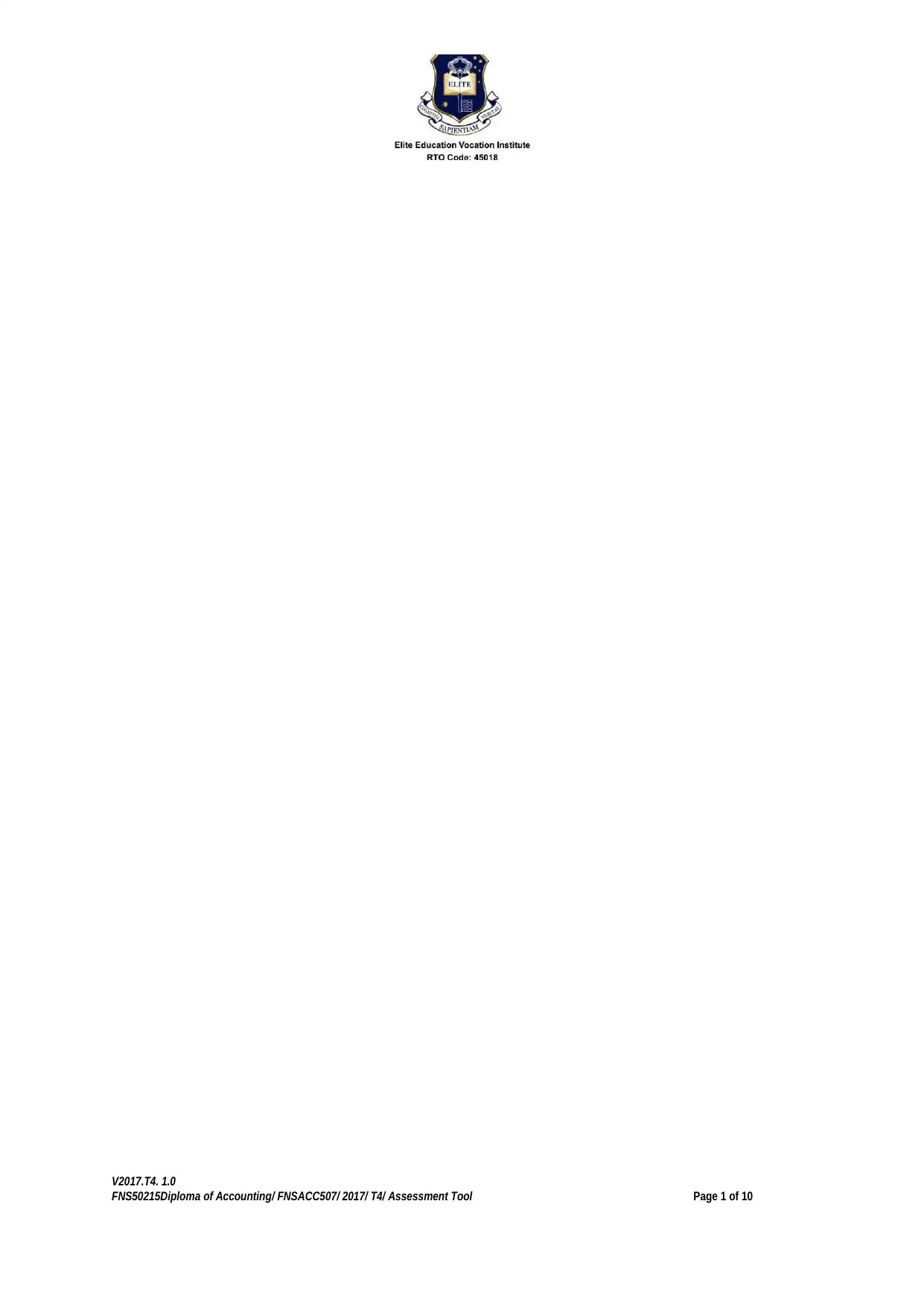
V2017.T4. 1.0
FNS50215Diploma of Accounting/ FNSACC507/ 2017/ T4/ Assessment Tool Page 1 of 10
FNS50215Diploma of Accounting/ FNSACC507/ 2017/ T4/ Assessment Tool Page 1 of 10
Paraphrase This Document
Need a fresh take? Get an instant paraphrase of this document with our AI Paraphraser
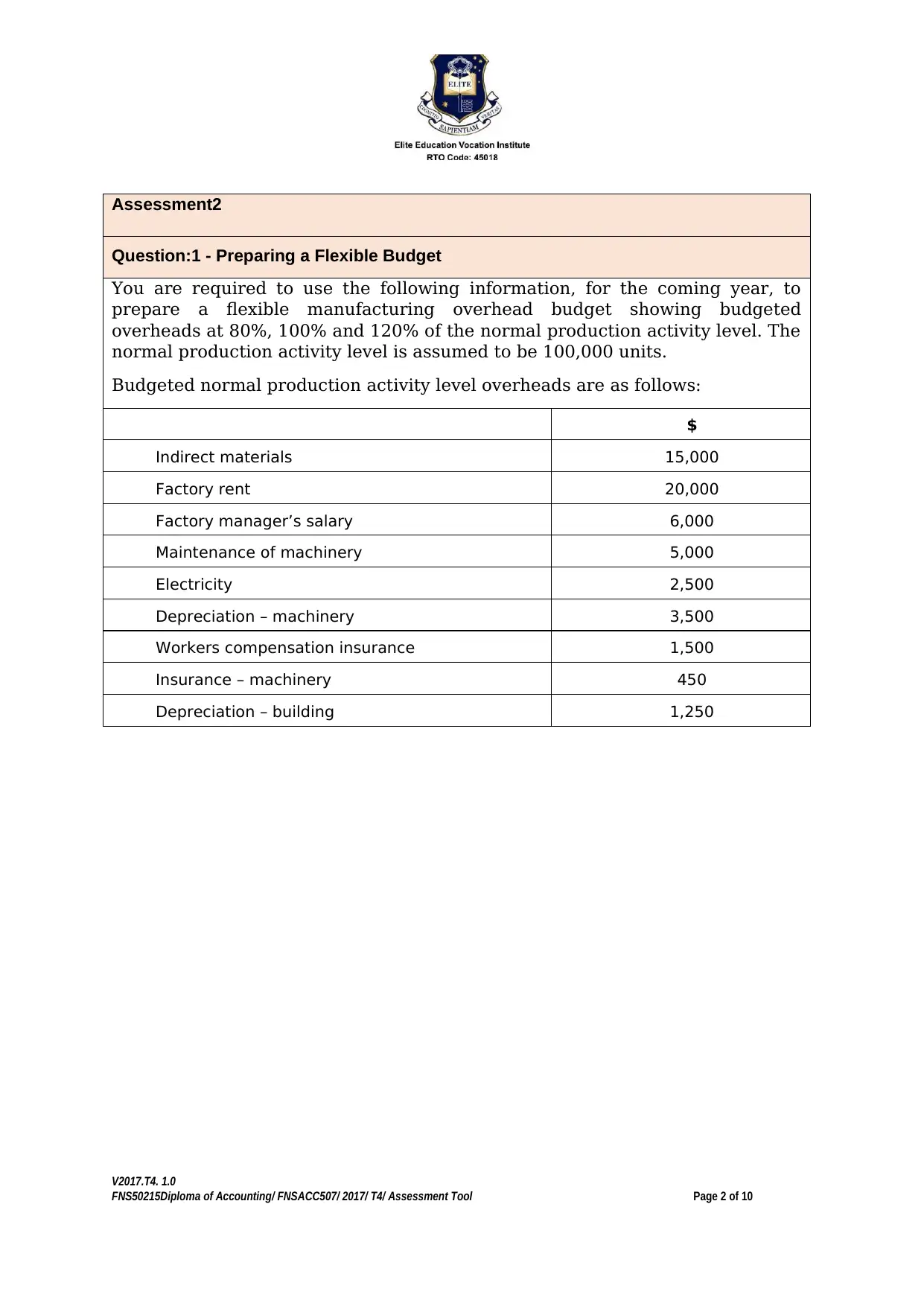
Assessment2
Question:1 - Preparing a Flexible Budget
You are required to use the following information, for the coming year, to
prepare a flexible manufacturing overhead budget showing budgeted
overheads at 80%, 100% and 120% of the normal production activity level. The
normal production activity level is assumed to be 100,000 units.
Budgeted normal production activity level overheads are as follows:
$
Indirect materials 15,000
Factory rent 20,000
Factory manager’s salary 6,000
Maintenance of machinery 5,000
Electricity 2,500
Depreciation – machinery 3,500
Workers compensation insurance 1,500
Insurance – machinery 450
Depreciation – building 1,250
V2017.T4. 1.0
FNS50215Diploma of Accounting/ FNSACC507/ 2017/ T4/ Assessment Tool Page 2 of 10
Question:1 - Preparing a Flexible Budget
You are required to use the following information, for the coming year, to
prepare a flexible manufacturing overhead budget showing budgeted
overheads at 80%, 100% and 120% of the normal production activity level. The
normal production activity level is assumed to be 100,000 units.
Budgeted normal production activity level overheads are as follows:
$
Indirect materials 15,000
Factory rent 20,000
Factory manager’s salary 6,000
Maintenance of machinery 5,000
Electricity 2,500
Depreciation – machinery 3,500
Workers compensation insurance 1,500
Insurance – machinery 450
Depreciation – building 1,250
V2017.T4. 1.0
FNS50215Diploma of Accounting/ FNSACC507/ 2017/ T4/ Assessment Tool Page 2 of 10
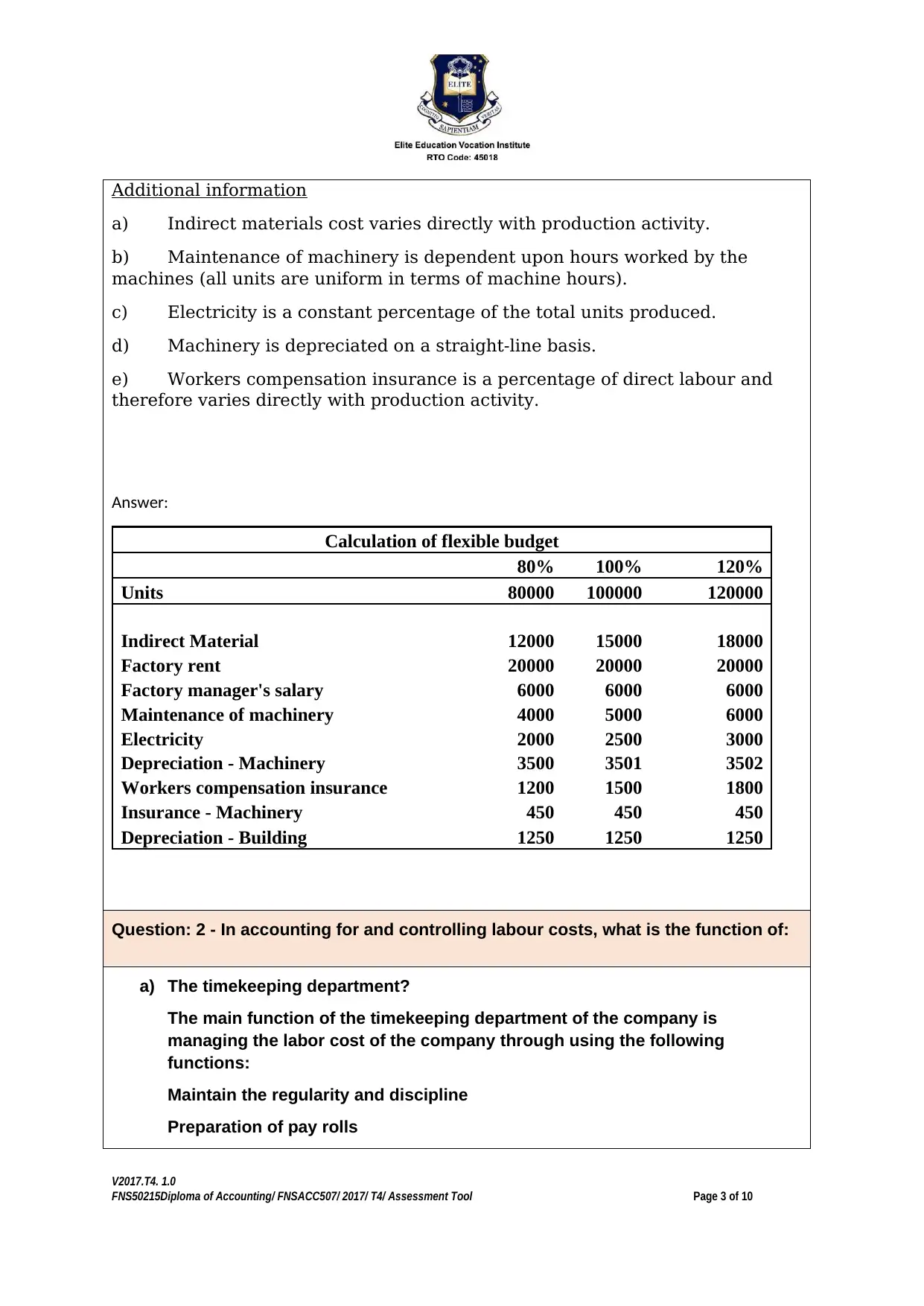
Additional information
a) Indirect materials cost varies directly with production activity.
b) Maintenance of machinery is dependent upon hours worked by the
machines (all units are uniform in terms of machine hours).
c) Electricity is a constant percentage of the total units produced.
d) Machinery is depreciated on a straight-line basis.
e) Workers compensation insurance is a percentage of direct labour and
therefore varies directly with production activity.
Answer:
Calculation of flexible budget
80% 100% 120%
Units 80000 100000 120000
Indirect Material 12000 15000 18000
Factory rent 20000 20000 20000
Factory manager's salary 6000 6000 6000
Maintenance of machinery 4000 5000 6000
Electricity 2000 2500 3000
Depreciation - Machinery 3500 3501 3502
Workers compensation insurance 1200 1500 1800
Insurance - Machinery 450 450 450
Depreciation - Building 1250 1250 1250
Question: 2 - In accounting for and controlling labour costs, what is the function of:
a) The timekeeping department?
The main function of the timekeeping department of the company is
managing the labor cost of the company through using the following
functions:
Maintain the regularity and discipline
Preparation of pay rolls
V2017.T4. 1.0
FNS50215Diploma of Accounting/ FNSACC507/ 2017/ T4/ Assessment Tool Page 3 of 10
a) Indirect materials cost varies directly with production activity.
b) Maintenance of machinery is dependent upon hours worked by the
machines (all units are uniform in terms of machine hours).
c) Electricity is a constant percentage of the total units produced.
d) Machinery is depreciated on a straight-line basis.
e) Workers compensation insurance is a percentage of direct labour and
therefore varies directly with production activity.
Answer:
Calculation of flexible budget
80% 100% 120%
Units 80000 100000 120000
Indirect Material 12000 15000 18000
Factory rent 20000 20000 20000
Factory manager's salary 6000 6000 6000
Maintenance of machinery 4000 5000 6000
Electricity 2000 2500 3000
Depreciation - Machinery 3500 3501 3502
Workers compensation insurance 1200 1500 1800
Insurance - Machinery 450 450 450
Depreciation - Building 1250 1250 1250
Question: 2 - In accounting for and controlling labour costs, what is the function of:
a) The timekeeping department?
The main function of the timekeeping department of the company is
managing the labor cost of the company through using the following
functions:
Maintain the regularity and discipline
Preparation of pay rolls
V2017.T4. 1.0
FNS50215Diploma of Accounting/ FNSACC507/ 2017/ T4/ Assessment Tool Page 3 of 10
⊘ This is a preview!⊘
Do you want full access?
Subscribe today to unlock all pages.

Trusted by 1+ million students worldwide
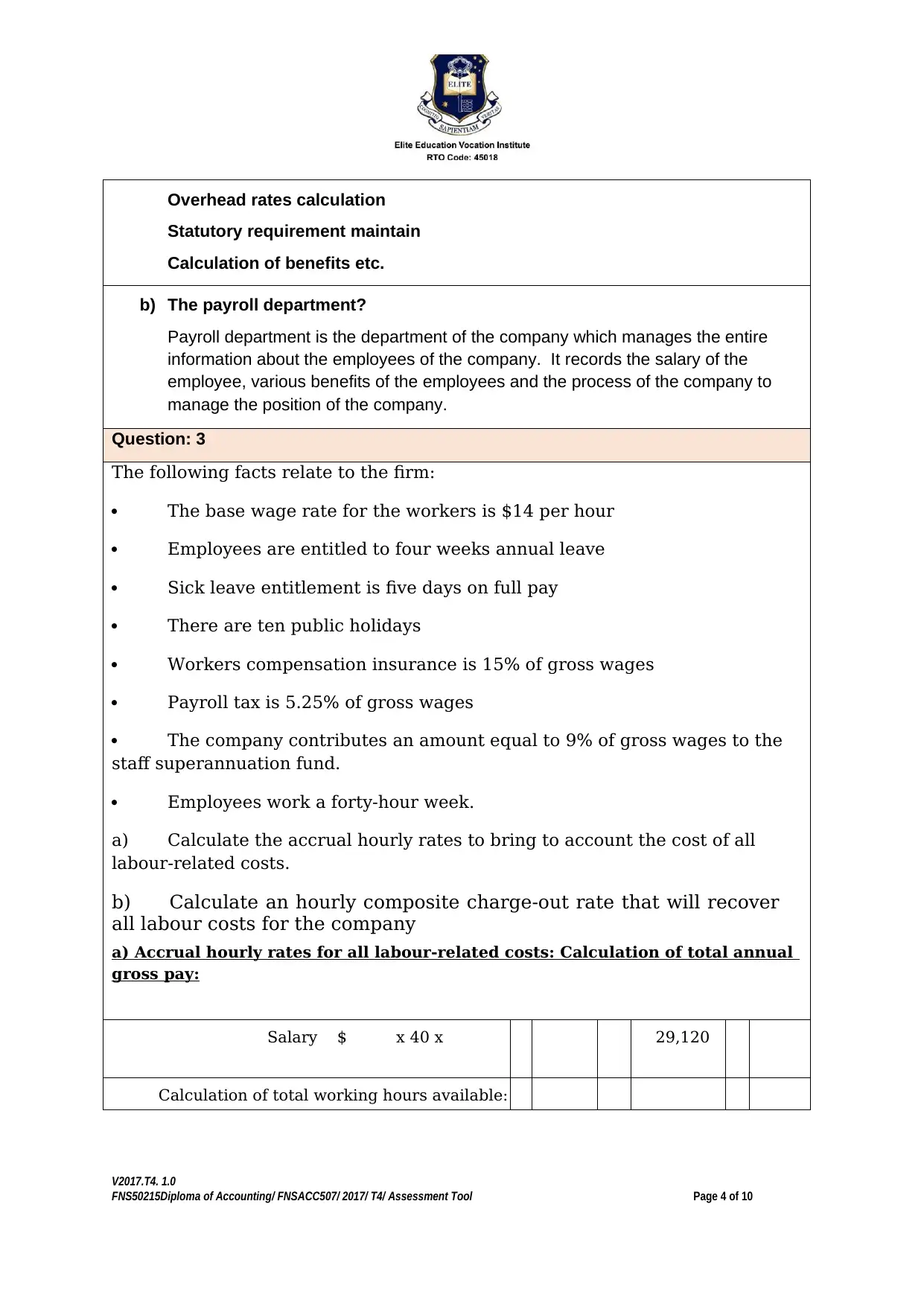
Overhead rates calculation
Statutory requirement maintain
Calculation of benefits etc.
b) The payroll department?
Payroll department is the department of the company which manages the entire
information about the employees of the company. It records the salary of the
employee, various benefits of the employees and the process of the company to
manage the position of the company.
Question: 3
The following facts relate to the firm:
· The base wage rate for the workers is $14 per hour
· Employees are entitled to four weeks annual leave
· Sick leave entitlement is five days on full pay
· There are ten public holidays
· Workers compensation insurance is 15% of gross wages
· Payroll tax is 5.25% of gross wages
· The company contributes an amount equal to 9% of gross wages to the
staff superannuation fund.
· Employees work a forty-hour week.
a) Calculate the accrual hourly rates to bring to account the cost of all
labour-related costs.
b) Calculate an hourly composite charge-out rate that will recover
all labour costs for the company
a) Accrual hourly rates for all labour-related costs: Calculation of total annual
gross pay:
Salary $ x 40 x 29,120
Calculation of total working hours available:
V2017.T4. 1.0
FNS50215Diploma of Accounting/ FNSACC507/ 2017/ T4/ Assessment Tool Page 4 of 10
Statutory requirement maintain
Calculation of benefits etc.
b) The payroll department?
Payroll department is the department of the company which manages the entire
information about the employees of the company. It records the salary of the
employee, various benefits of the employees and the process of the company to
manage the position of the company.
Question: 3
The following facts relate to the firm:
· The base wage rate for the workers is $14 per hour
· Employees are entitled to four weeks annual leave
· Sick leave entitlement is five days on full pay
· There are ten public holidays
· Workers compensation insurance is 15% of gross wages
· Payroll tax is 5.25% of gross wages
· The company contributes an amount equal to 9% of gross wages to the
staff superannuation fund.
· Employees work a forty-hour week.
a) Calculate the accrual hourly rates to bring to account the cost of all
labour-related costs.
b) Calculate an hourly composite charge-out rate that will recover
all labour costs for the company
a) Accrual hourly rates for all labour-related costs: Calculation of total annual
gross pay:
Salary $ x 40 x 29,120
Calculation of total working hours available:
V2017.T4. 1.0
FNS50215Diploma of Accounting/ FNSACC507/ 2017/ T4/ Assessment Tool Page 4 of 10
Paraphrase This Document
Need a fresh take? Get an instant paraphrase of this document with our AI Paraphraser

Maximum = × 40
Deduct: annual leave 40 × 4
sick leave 1
public holidays
1480
Actual working hours available 1480
Calculation of total leave costs per
employee:
280 hours X 5509.19
Hourly leave cost = 1,800
= $
3.1
Calculation of payroll tax hourly per employee:
5.25% × $ $ 289.2
Hourly payroll tax cost = $ ÷
1,800
$ 0.16056
Calculation of workers compensation hourly cost per employee:
15% × $ $ 495.827
Hourly cost = $ ÷ 1800 $3.06
Calculation of company superannuation contributions per
employee
9% × $ $ 495.827
Hourly cost = $ ÷
1,800
$ 0.306
V2017.T4. 1.0
FNS50215Diploma of Accounting/ FNSACC507/ 2017/ T4/ Assessment Tool Page 5 of 10
Deduct: annual leave 40 × 4
sick leave 1
public holidays
1480
Actual working hours available 1480
Calculation of total leave costs per
employee:
280 hours X 5509.19
Hourly leave cost = 1,800
= $
3.1
Calculation of payroll tax hourly per employee:
5.25% × $ $ 289.2
Hourly payroll tax cost = $ ÷
1,800
$ 0.16056
Calculation of workers compensation hourly cost per employee:
15% × $ $ 495.827
Hourly cost = $ ÷ 1800 $3.06
Calculation of company superannuation contributions per
employee
9% × $ $ 495.827
Hourly cost = $ ÷
1,800
$ 0.306
V2017.T4. 1.0
FNS50215Diploma of Accounting/ FNSACC507/ 2017/ T4/ Assessment Tool Page 5 of 10
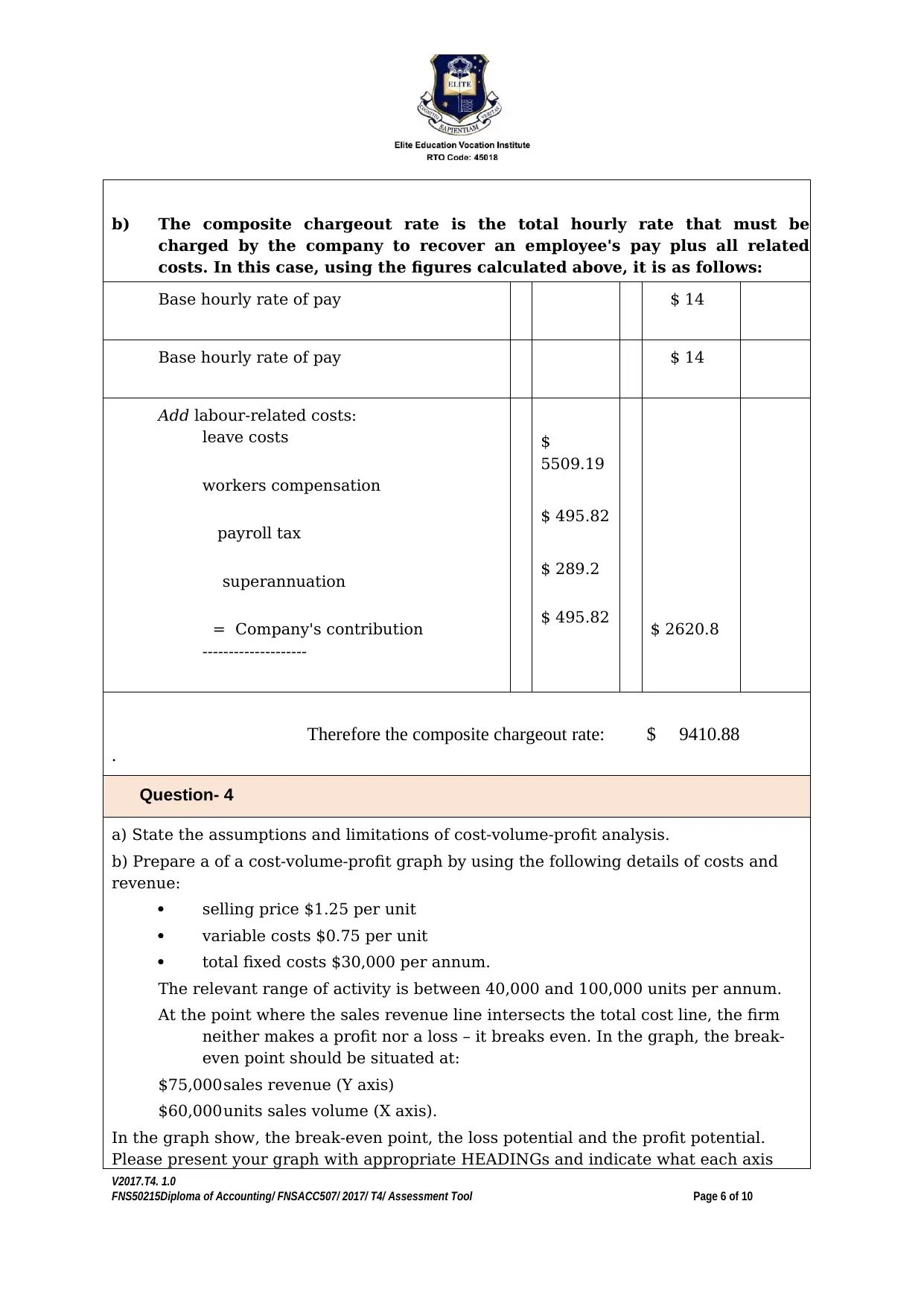
b) The composite chargeout rate is the total hourly rate that must be
charged by the company to recover an employee's pay plus all related
costs. In this case, using the figures calculated above, it is as follows:
Base hourly rate of pay $ 14
Base hourly rate of pay $ 14
Add labour-related costs:
leave costs
workers compensation
payroll tax
superannuation
= Company's contribution
--------------------
$
5509.19
$ 495.82
$ 289.2
$ 495.82 $ 2620.8
Therefore the composite chargeout rate: $ 9410.88
.
Question- 4
a) State the assumptions and limitations of cost-volume-profit analysis.
b) Prepare a of a cost-volume-profit graph by using the following details of costs and
revenue:
· selling price $1.25 per unit
· variable costs $0.75 per unit
· total fixed costs $30,000 per annum.
The relevant range of activity is between 40,000 and 100,000 units per annum.
At the point where the sales revenue line intersects the total cost line, the firm
neither makes a profit nor a loss – it breaks even. In the graph, the break-
even point should be situated at:
$75,000sales revenue (Y axis)
$60,000units sales volume (X axis).
In the graph show, the break-even point, the loss potential and the profit potential.
Please present your graph with appropriate HEADINGs and indicate what each axis
V2017.T4. 1.0
FNS50215Diploma of Accounting/ FNSACC507/ 2017/ T4/ Assessment Tool Page 6 of 10
charged by the company to recover an employee's pay plus all related
costs. In this case, using the figures calculated above, it is as follows:
Base hourly rate of pay $ 14
Base hourly rate of pay $ 14
Add labour-related costs:
leave costs
workers compensation
payroll tax
superannuation
= Company's contribution
--------------------
$
5509.19
$ 495.82
$ 289.2
$ 495.82 $ 2620.8
Therefore the composite chargeout rate: $ 9410.88
.
Question- 4
a) State the assumptions and limitations of cost-volume-profit analysis.
b) Prepare a of a cost-volume-profit graph by using the following details of costs and
revenue:
· selling price $1.25 per unit
· variable costs $0.75 per unit
· total fixed costs $30,000 per annum.
The relevant range of activity is between 40,000 and 100,000 units per annum.
At the point where the sales revenue line intersects the total cost line, the firm
neither makes a profit nor a loss – it breaks even. In the graph, the break-
even point should be situated at:
$75,000sales revenue (Y axis)
$60,000units sales volume (X axis).
In the graph show, the break-even point, the loss potential and the profit potential.
Please present your graph with appropriate HEADINGs and indicate what each axis
V2017.T4. 1.0
FNS50215Diploma of Accounting/ FNSACC507/ 2017/ T4/ Assessment Tool Page 6 of 10
⊘ This is a preview!⊘
Do you want full access?
Subscribe today to unlock all pages.

Trusted by 1+ million students worldwide
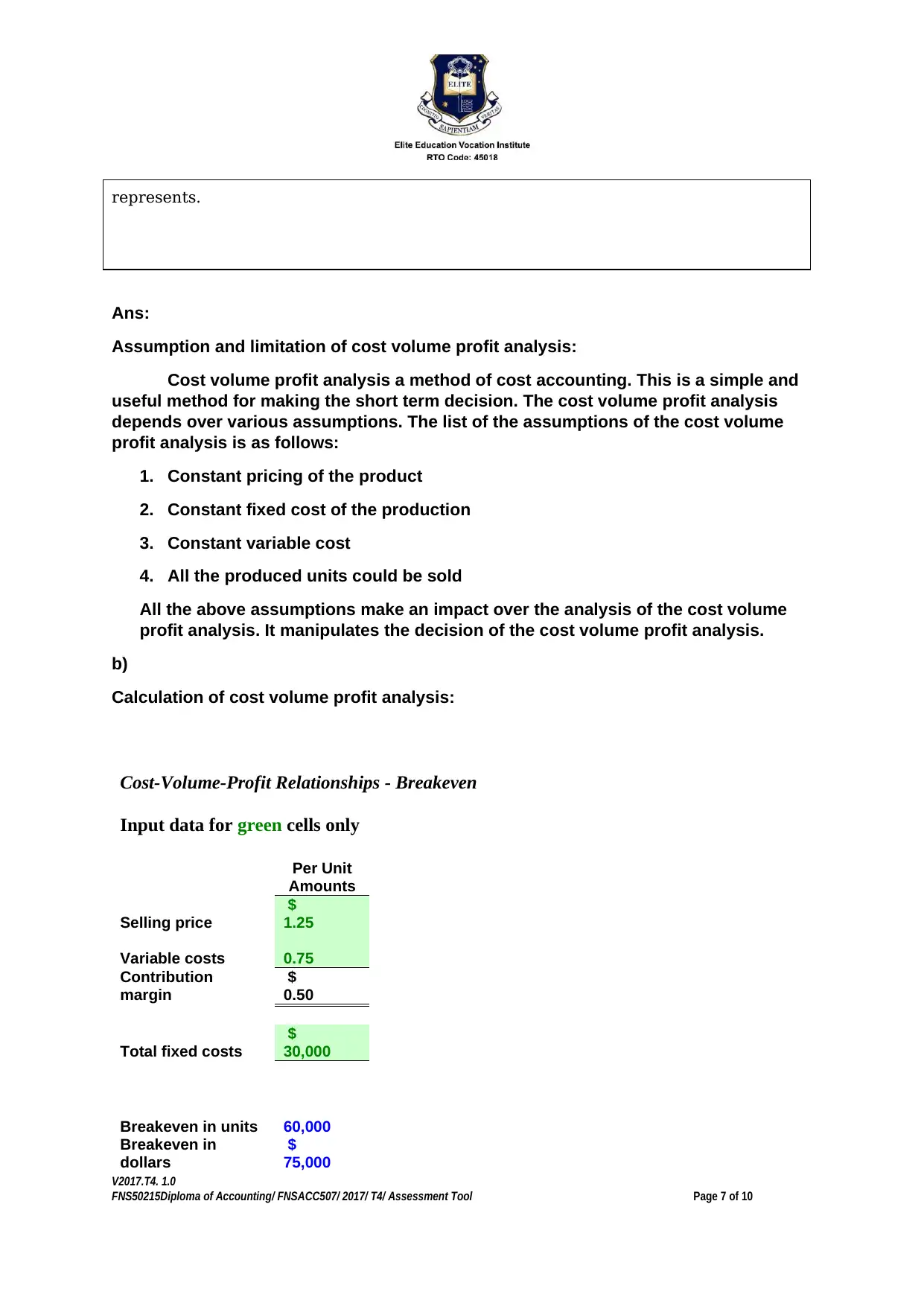
represents.
Ans:
Assumption and limitation of cost volume profit analysis:
Cost volume profit analysis a method of cost accounting. This is a simple and
useful method for making the short term decision. The cost volume profit analysis
depends over various assumptions. The list of the assumptions of the cost volume
profit analysis is as follows:
1. Constant pricing of the product
2. Constant fixed cost of the production
3. Constant variable cost
4. All the produced units could be sold
All the above assumptions make an impact over the analysis of the cost volume
profit analysis. It manipulates the decision of the cost volume profit analysis.
b)
Calculation of cost volume profit analysis:
Cost-Volume-Profit Relationships - Breakeven
Input data for green cells only
Per Unit
Amounts
Selling price
$
1.25
Variable costs 0.75
Contribution
margin
$
0.50
Total fixed costs
$
30,000
Breakeven in units 60,000
Breakeven in
dollars
$
75,000
V2017.T4. 1.0
FNS50215Diploma of Accounting/ FNSACC507/ 2017/ T4/ Assessment Tool Page 7 of 10
Ans:
Assumption and limitation of cost volume profit analysis:
Cost volume profit analysis a method of cost accounting. This is a simple and
useful method for making the short term decision. The cost volume profit analysis
depends over various assumptions. The list of the assumptions of the cost volume
profit analysis is as follows:
1. Constant pricing of the product
2. Constant fixed cost of the production
3. Constant variable cost
4. All the produced units could be sold
All the above assumptions make an impact over the analysis of the cost volume
profit analysis. It manipulates the decision of the cost volume profit analysis.
b)
Calculation of cost volume profit analysis:
Cost-Volume-Profit Relationships - Breakeven
Input data for green cells only
Per Unit
Amounts
Selling price
$
1.25
Variable costs 0.75
Contribution
margin
$
0.50
Total fixed costs
$
30,000
Breakeven in units 60,000
Breakeven in
dollars
$
75,000
V2017.T4. 1.0
FNS50215Diploma of Accounting/ FNSACC507/ 2017/ T4/ Assessment Tool Page 7 of 10
Paraphrase This Document
Need a fresh take? Get an instant paraphrase of this document with our AI Paraphraser
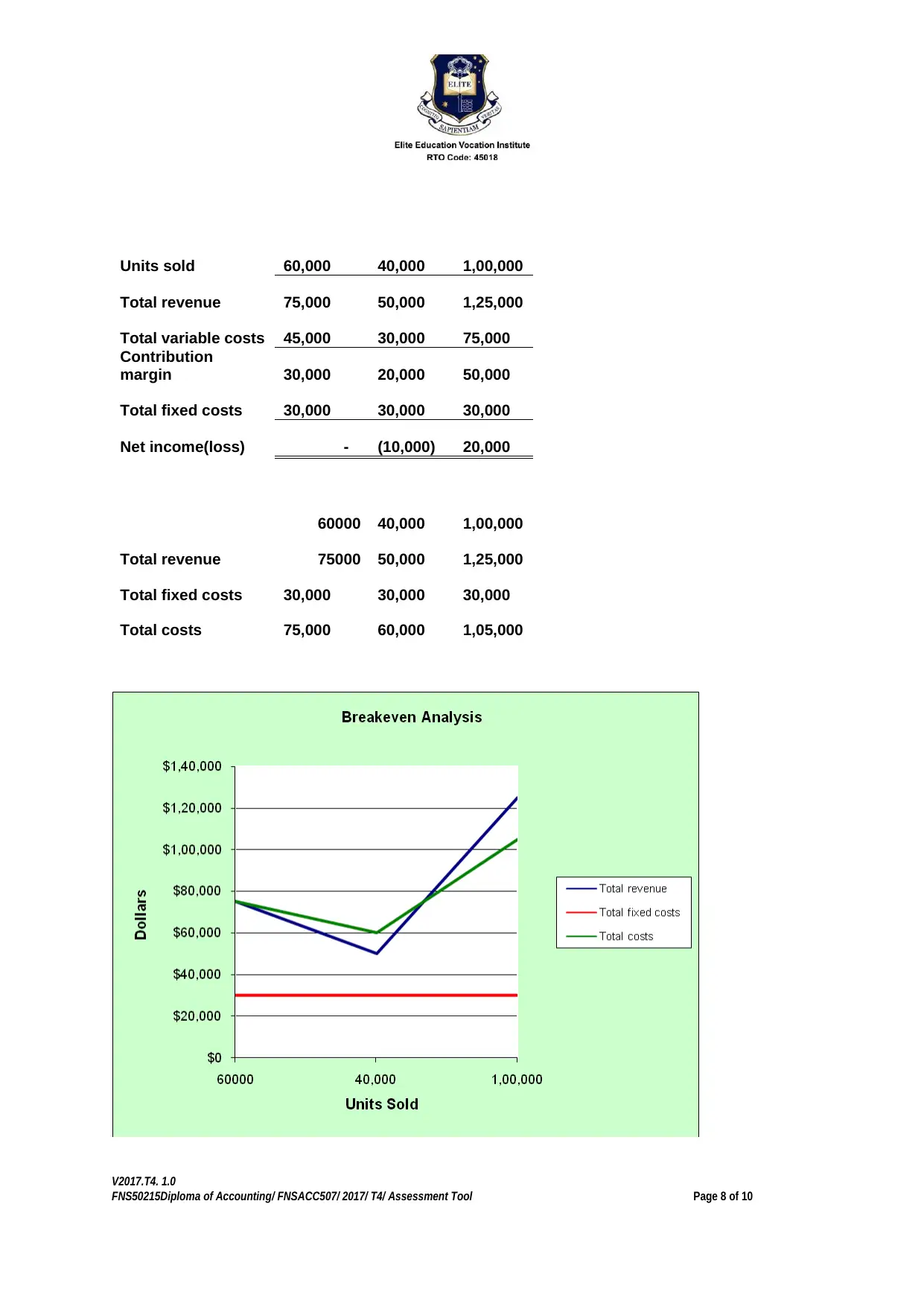
Units sold 60,000 40,000 1,00,000
Total revenue 75,000 50,000 1,25,000
Total variable costs 45,000 30,000 75,000
Contribution
margin 30,000 20,000 50,000
Total fixed costs 30,000 30,000 30,000
Net income(loss) - (10,000) 20,000
60000 40,000 1,00,000
Total revenue 75000 50,000 1,25,000
Total fixed costs 30,000 30,000 30,000
Total costs 75,000 60,000 1,05,000
V2017.T4. 1.0
FNS50215Diploma of Accounting/ FNSACC507/ 2017/ T4/ Assessment Tool Page 8 of 10
Total revenue 75,000 50,000 1,25,000
Total variable costs 45,000 30,000 75,000
Contribution
margin 30,000 20,000 50,000
Total fixed costs 30,000 30,000 30,000
Net income(loss) - (10,000) 20,000
60000 40,000 1,00,000
Total revenue 75000 50,000 1,25,000
Total fixed costs 30,000 30,000 30,000
Total costs 75,000 60,000 1,05,000
V2017.T4. 1.0
FNS50215Diploma of Accounting/ FNSACC507/ 2017/ T4/ Assessment Tool Page 8 of 10
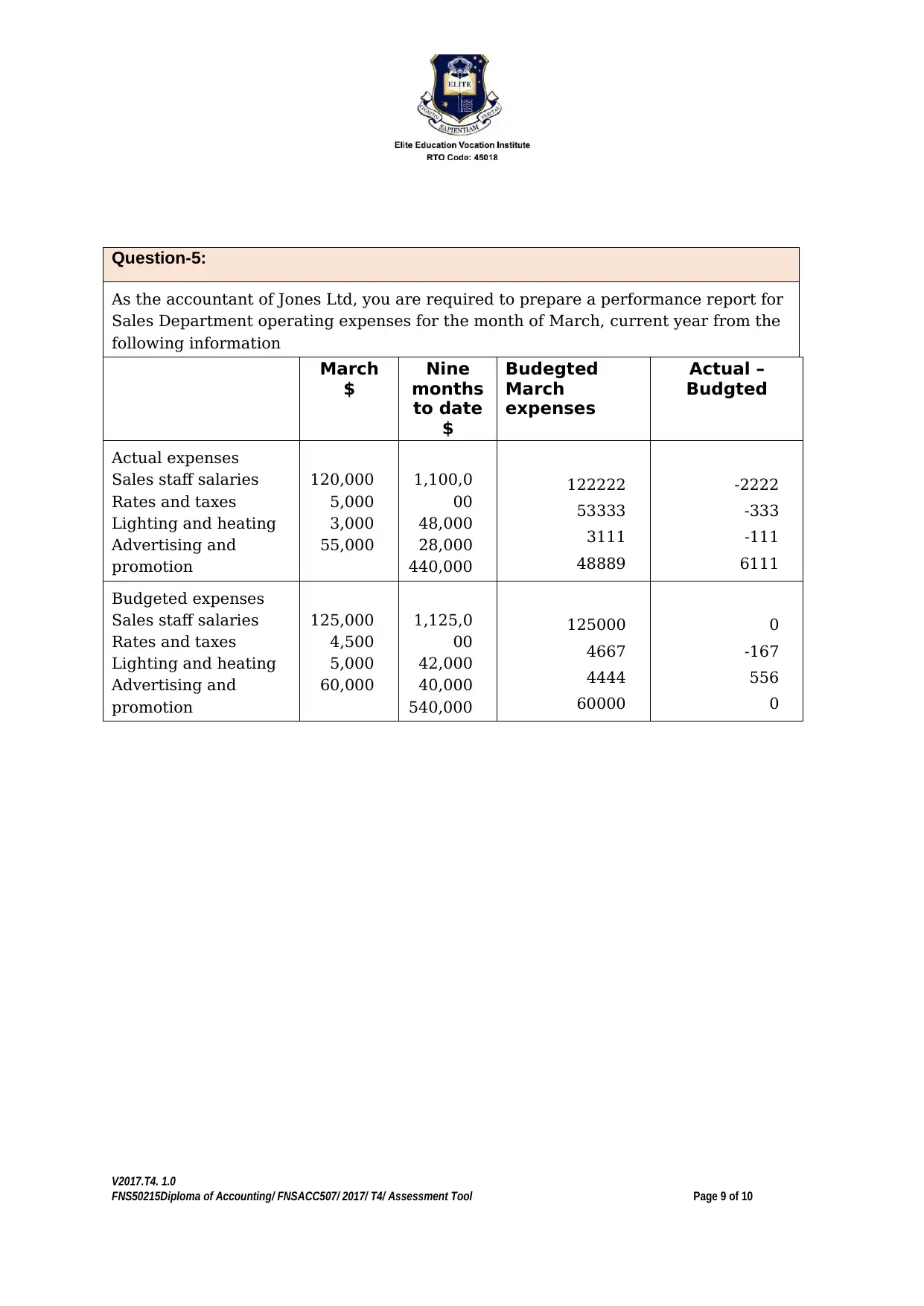
Question-5:
As the accountant of Jones Ltd, you are required to prepare a performance report for
Sales Department operating expenses for the month of March, current year from the
following information
March
$
Nine
months
to date
$
Budegted
March
expenses
Actual –
Budgted
Actual expenses
Sales staff salaries
Rates and taxes
Lighting and heating
Advertising and
promotion
120,000
5,000
3,000
55,000
1,100,0
00
48,000
28,000
440,000
122222
53333
3111
48889
-2222
-333
-111
6111
Budgeted expenses
Sales staff salaries
Rates and taxes
Lighting and heating
Advertising and
promotion
125,000
4,500
5,000
60,000
1,125,0
00
42,000
40,000
540,000
125000
4667
4444
60000
0
-167
556
0
V2017.T4. 1.0
FNS50215Diploma of Accounting/ FNSACC507/ 2017/ T4/ Assessment Tool Page 9 of 10
As the accountant of Jones Ltd, you are required to prepare a performance report for
Sales Department operating expenses for the month of March, current year from the
following information
March
$
Nine
months
to date
$
Budegted
March
expenses
Actual –
Budgted
Actual expenses
Sales staff salaries
Rates and taxes
Lighting and heating
Advertising and
promotion
120,000
5,000
3,000
55,000
1,100,0
00
48,000
28,000
440,000
122222
53333
3111
48889
-2222
-333
-111
6111
Budgeted expenses
Sales staff salaries
Rates and taxes
Lighting and heating
Advertising and
promotion
125,000
4,500
5,000
60,000
1,125,0
00
42,000
40,000
540,000
125000
4667
4444
60000
0
-167
556
0
V2017.T4. 1.0
FNS50215Diploma of Accounting/ FNSACC507/ 2017/ T4/ Assessment Tool Page 9 of 10
⊘ This is a preview!⊘
Do you want full access?
Subscribe today to unlock all pages.

Trusted by 1+ million students worldwide
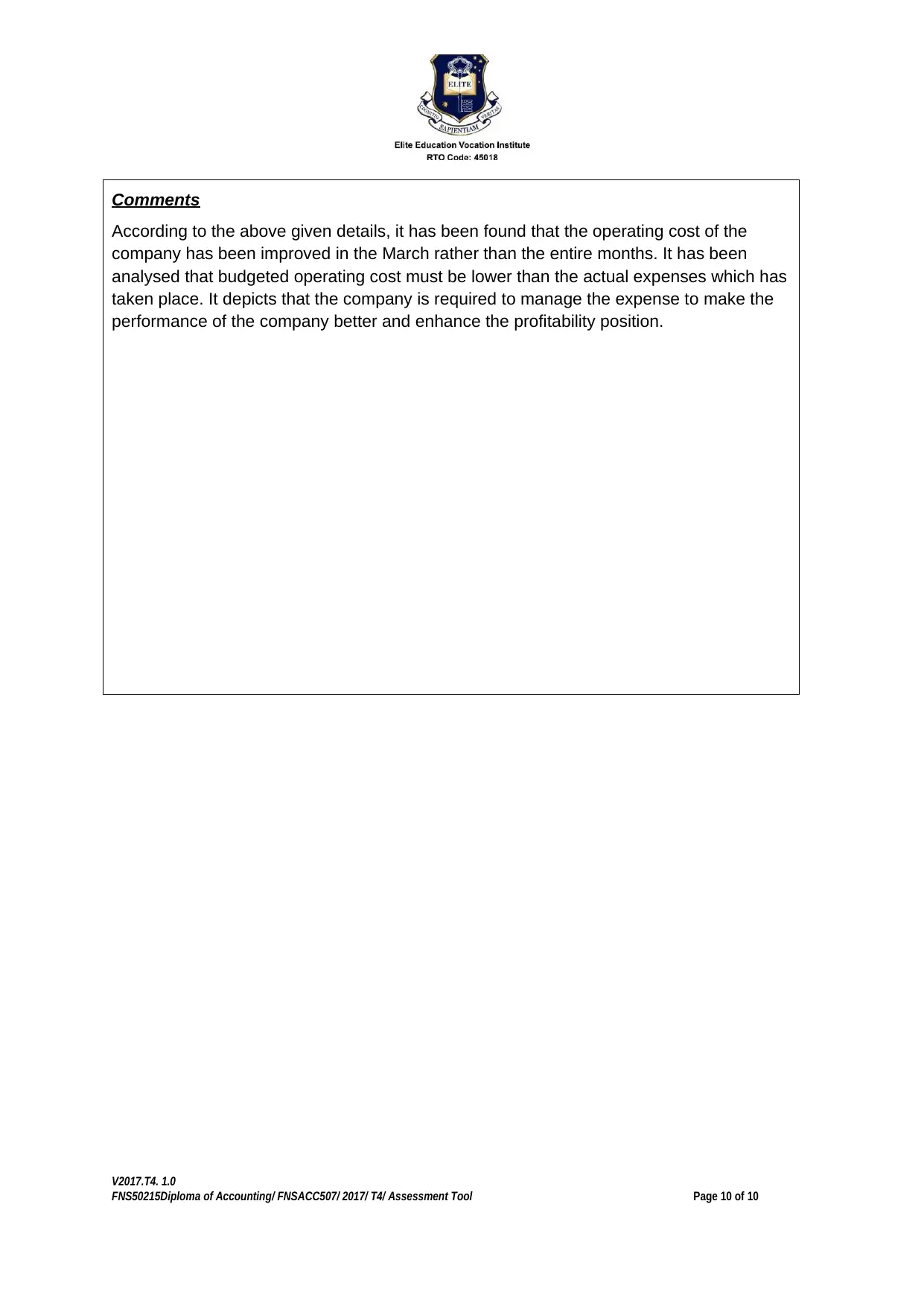
Comments
According to the above given details, it has been found that the operating cost of the
company has been improved in the March rather than the entire months. It has been
analysed that budgeted operating cost must be lower than the actual expenses which has
taken place. It depicts that the company is required to manage the expense to make the
performance of the company better and enhance the profitability position.
V2017.T4. 1.0
FNS50215Diploma of Accounting/ FNSACC507/ 2017/ T4/ Assessment Tool Page 10 of 10
According to the above given details, it has been found that the operating cost of the
company has been improved in the March rather than the entire months. It has been
analysed that budgeted operating cost must be lower than the actual expenses which has
taken place. It depicts that the company is required to manage the expense to make the
performance of the company better and enhance the profitability position.
V2017.T4. 1.0
FNS50215Diploma of Accounting/ FNSACC507/ 2017/ T4/ Assessment Tool Page 10 of 10
1 out of 10
Your All-in-One AI-Powered Toolkit for Academic Success.
+13062052269
info@desklib.com
Available 24*7 on WhatsApp / Email
![[object Object]](/_next/static/media/star-bottom.7253800d.svg)
Unlock your academic potential
Copyright © 2020–2025 A2Z Services. All Rights Reserved. Developed and managed by ZUCOL.